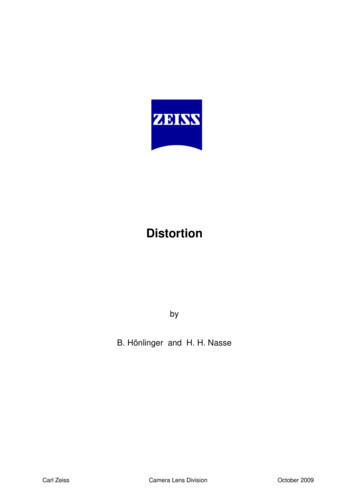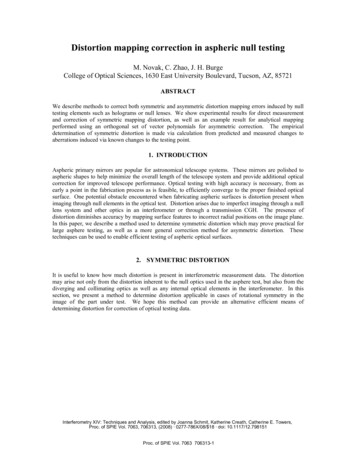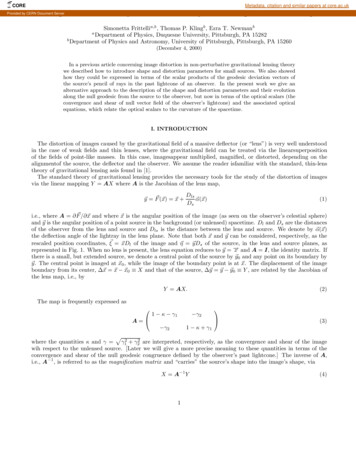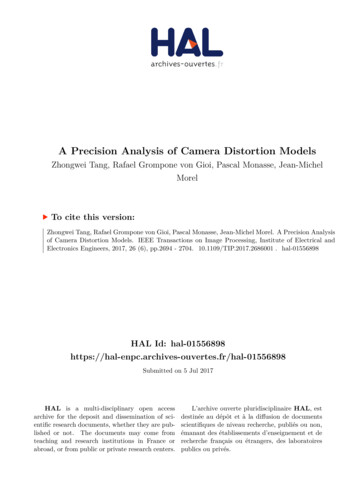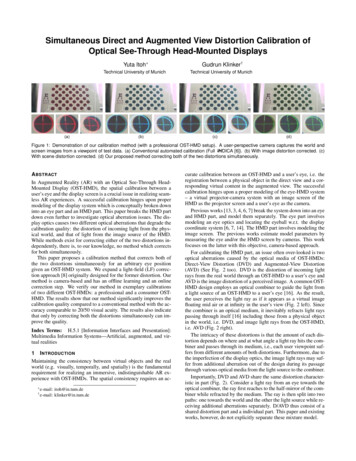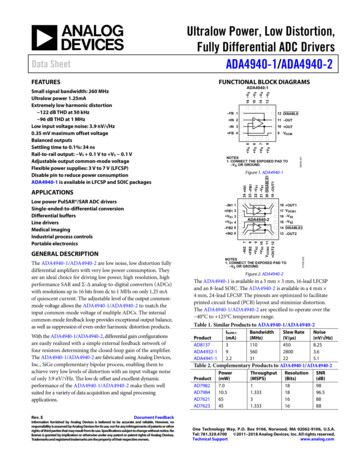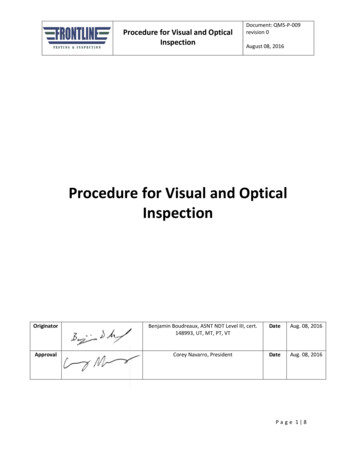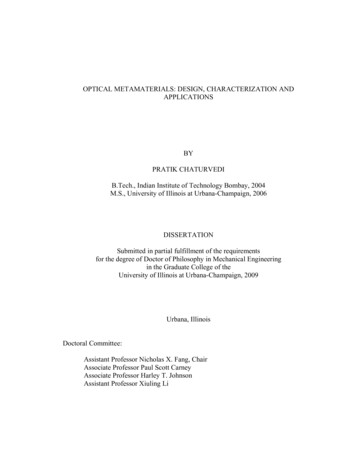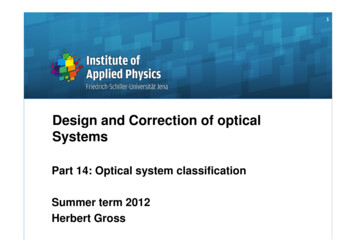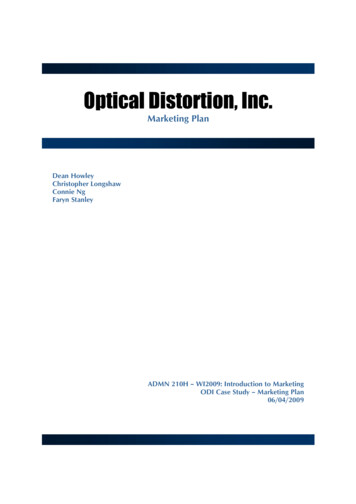
Transcription
Optical Distortion, Inc.Marketing PlanDean HowleyChristopher LongshawConnie NgFaryn StanleyADMN 210H – WI2009: Introduction to MarketingODI Case Study – Marketing Plan06/04/2009
Optical Distortion, Inc.Marketing PlanContentsExecutive Summary 1Background 2Product 7Place 8Promotion 9Price 10Recommendations 14Exhibits 15
Executive SummaryOptical Distortion, Inc. is the manufacturer of the worlds first contact lens foragricultural use; the ODI contact lens. The innovative product is designed for use in theegg producing chicken industry and provides a simple, humane, effective, cost saving,and profitable technological advancement to farmers within the industry.This document will develop a strategic direction for the marketing of OpticalDistortion, Inc. and the ODI contact lens through the exploration of numerous factors thatimpact the effectiveness of a company within the market.First, the background of the company, of its competitors, and of its customers willbe explored, providing a base for further discussion of the product.Second, an identification of the appropriate segmenting, targeting, and positioningstrategies for Optical Distortion, Inc and the ODI contact lens will occur, providing abasic understanding of the market structure to which the company and product will beentering.Third, the evaluation of the company and product’s strengths, weaknesses,opportunities, and threats will be made, identifying the key areas to be valued as anadvantage, and those which require some attention to ensure effectiveness.Fourth, an exploration of Optical Distortion, Inc.’s product, place, promotion, andprice strategies will occur, rounding out the items that form the strategic direction of thecompany and the initial product launch.Finally, using the current strategies as a guide, a recommendation of keyconsiderations for the future will be made, indicating where future strategic decisionsneed to be made, and how this marketing plan can form a starting point for the futuresuccess of Optical Distortion, Inc. as a company, and the ODI contact lens as a product.Optical Distortion, Inc. Marketing Plan1
BackgroundThe Three C’s – Company, Competition, and CustomerCompanyOriginally invented in 1965 to mimic the effect of cataracts on chickens, thecontact lens for use on chickens was a result of collaboration between Robert D.Garrison, an inventor, and Ronald Olson, an owner of a large chicken farm in Oregon.After product conceptualization, development, and testing, the two men, accompanied byan investor, saw the project as feasible and by late 1966 they had formed a corporation;Optical Distortion, Inc. (ODI).The company was formed in response to the relatively ineffective practice ofdebeaking. The process of debeaking is the current and most popular process of trimmingthe chicken’s beaks in order to prevent cannibalism, which is caused by the closeproximity of the birds to each other within their cages. By debeaking the chickens, theirmethod of attack is eliminated and therefore morality rates are decreased and productivityis improved. However, the process of debeaking carries a host of problems such astrauma, temporary weight loss, and retardation of egg production. Consequently,Garrison and Olson saw a need for an improved process and from that need developedthe ODI contact lens.Two of the most important assets for Optical Distortion, Inc. are its United Statesproduct patent on the ODI contact lens and the company’s contract with New WorldPlastics. In 1969 Optical Distortion, Inc. was granted a patent for the use of a polymer.This polymer was the same matter used by Bausch and Lomb to produce soft contactlenses for humans, and was controlled by New World Plastics. Unfortunately thehydrophilic polymer could not be injection moulded, and therefore was not appropriatefor production of the ODI contact lens. Alternative production processes were simply tooexpensive, and with New World Plastics’ polymer being the only material known at thetime to produce soft contact lenses, production was halted. However, in 1973 RobertGarrison’s grandson Daniel Garrison contacted New World Plastics to investigate if anynew developments had occurred with the hydrophilic polymer. As it turns out, NewWorld had discovered a method that allowed polymer to be injection moulded and thus,Optical Distortion, Inc. entered into a contract with New World Plastics that gave thecompany exclusive use of hydrophilic polymer for nonhuman use.The company is still in a growth phase and as Olson explained “there’s a lot atstake here; more than enough potential for a big company to put fifty people on theproject.” It is from this point that the strategic direction of this marketing plan will beginto shape the way Optical Distortion, Inc. grows into an expanding and prosperouscompany.Optical Distortion, Inc. Marketing Plan2
CompetitionAlthough there is no direct competition in the chicken contact lens market, thereal ‘need’ being addressed is the taming of chickens through the reduction of aggressiveand cannibalistic behaviour. Until now, with the development of the ODI contact lens, theprocess of debeaking has been the only process to address this need for the past fiftyyears, and is therefore the main competitor of Optical Distortion, Inc. Given thissituation, the entrance of ODI into the nearly monopolistic, but actually oligopolisticmarket structure, has turned that structure from a series of companies competing withonly one process, to a series of companies now competing against each other as well asanother process, creating a truly oligopolistic market structure containing both direct andindirect competition.The debeaking process seeks to prevent chickens from using their beak as aweapon. The operation entails using a hot knife and anvil to cut off the upper and lowermandibles of a chicken’s beak at different lengths. The beak is then pressed upon a hotknife to seal the wound and stop excess bleeding. Although this process is successful atrendering the beak less harmful in chicken attacks, the trauma it inflicts upon thechickens makes the process more detrimental than productive. The severity of the traumais seen through temporary weight loss, retardation of egg production for approximately aweek, and increased social stress for the chickens. Despite the fact that the debeakingprocess lowers chicken morality caused by cannibalism from 25% to 9%, there are heavyand drastic repercussions for the chickens and farmers, in terms of production andchicken morale.The costs associated with debeaking are mostly composed of labour. The processusually involves three labourers who earn approximately 2.50 each, per hour, who candebeak approximately 220 birds per hour.Given the described current market structure, it will be the purpose of thismarketing plan to enable an effective entrance of Optical Distortion, Inc into the marketas an indirect competitor to the debeaking process, which currently holds a monopoly onthe solution to the need at hand.CustomerIn order for Optical Distortion, Inc. to successfully sell the ODI contact lens tochicken farmers, it is essential for the company to understand the customer and theirspecific needs and wants. As Garrison stated “chicken farmers, even the big ones, are anindependent-minded breed of men who might react very unfavourably if they get the ideathat they have been taken” and as a result, it is important to show the chicken farmer howthe ODI contact lens meets their needs better than the competition.There are three broad categories of chicken farms in California: small, mediumand large. Small farms constitute 10,000 birds or fewer and are usually family operated.These farms most often sell their eggs directly to consumers or to local grocery, milk, oregg stores. The birds are often housed in henhouses of about 1000-2000 birds leavingfarmers with the need to purchase starter pullers only once or twice a year. Although it isOptical Distortion, Inc. Marketing Plan3
possible for chicken cannibalism to be a problem on small farms, it is more unlikelybecause the chickens are not placed in as close proximity to each other as in larger farmsand as such are less likely to attack one another. Therefore, because these small farms arenot greatly concerned by cannibalism the ODI contact lens does not truly fulfil a need forthem, and for that reason this customer group will not be targeted directly. Furthermore,because these farms consist of a maximum of 10,000 birds, the costs associated with theimplementation of the ODI contact lens would likely be too expensive. In addition, smallfarms are declining at a rate of approximately 25% per year and are therefore not a veryattractive market for Optical Distortion, Inc. to target.Medium size farms range from 10,000 to 50,000 birds and are usually managedprofessionally by the farmer. Due to the size of the farms, chicken cannibalism is often anissue, and as such many of these farmers are familiar with the debeaking process andhave utilized it in the past. Moreover, farms of this size often have yearly cash flows of 375,000, and therefore would be able to afford the purchase and insertion of the ODIcontact lenses. For those reasons, these medium sized farms will be directly targeted byOptical Distortion, Inc. for the sale of the ODI contact lenses. In this case however, I t isimportant for this group of customers to see the cost benefits specifically associated withODI contact lenses, as money is likely to be a significant factor in their decision making.Large size farms contain upwards of 50,000 birds and are closer to resembling asmall manufacturing firm than a farm. Administration of this firm is far more complexthan both small and medium size farms, and often several people are involved in thedecision making process. As a result, unlike the other two farms, which are largely run bya farmer who would make the majority of the decisions, Optical Distortion, Inc. mayneed to appeal to and convince multiple individuals to switch from the debeaking processto the ODI contact lens as their new prevention of chicken cannibalism. Although moneyis less likely to be a significant issue for this customer group, as their annual cash flowcan reach and even exceed 12 million, it is absolutely essential that the costeffectiveness and production enhancing ability of the ODI contact lens be made veryclear and prominent in the sales pitch. Regardless of these characteristics however, it iswithin this customer group that the majority of Optical Distortion, Inc.’s sales force willbe targeted.STP – Segmenting, Targeting, and PositioningSegmentingOptical Distortion, Inc. operates in the United States within the egg producingchicken industry. In order to effectively market agricultural contact lenses, the companymust realize impediments, and take advantage of all opportunities that will project ODIinto a favourable position as a market leader, and stave off competition. In order to do so,data has been collected to represent the entire industry within the United States toestablish the greatest outlet for ODI’s initial penetration into the market.Optical Distortion, Inc. Marketing Plan4
Currently, the egg producing chicken market encompasses 400 million chickenswithin the United States, embodying nearly 300,000 farms. The relevant data collectedsuggests the market is comprised of four market segments based upon farm populationdensity. The four segments are farms with bird populations of: upward of 100,000 birds;between 50,000 and 100,000 birds; between 20,000 and 50,000 birds; and less than20,000 birds. At first glance the data show that each segment contains: 20.6%; 11.4%;22.5%; and 45.5% respectively, as seen in Exhibit 14. These figures show that farms withless than 20,000 birds hold a near majority of the chicken population within the UnitedStates. However, with further analysis of Exhibit 14 the data show that the averagepopulation of birds within each farm, separated by segment, is: over 200,000 birds perfarm; more than 65,000 birds per farm; less than 30,000 birds per farm; and a meagre 571birds per farm respectively. Therefore, it will be most beneficial to market the ODIcontact lenses to more concentrated farms, placing priority with farms of populationdensities in upwards of 20,000 birds, which relating back to the analysis of the customerbase defines the market segment as the upper half of medium farms and large farms.TargetingWith a realistic understanding of the market segment, as defined by the size ofchicken farm and associated number of birds, to which the ODI contact lens will bedirected, it is possible to look more directly at the specific target market. As a startingplace, the geographic location of the product launch must align with the financial abilityof Optical Distortion, Inc. as well as be easily accessible for salespeople and technicians.On that basis, and based on the previous test locations, there are two options for thelocation of the product launch: California and Oregon. The decision can be quite easilymade however for two reasons. One, the area has already been subject to initial testingand is therefore more likely to recognize and accept the product. And two, California hastraditionally been an innovator in the area of chicken farming and is therefore more likelyto accept a movement away from the traditional practice of debeaking.In more detail, the California market can be broken down numerically as a meansof further defining the specific market that the initial product launch of ODI contactlenses will target. From Exhibit 1 and Exhibit 2 it is possible to strategically isolate thetarget market in which the product launch will occur by considering three factors. First,the total number of chicken farms located in California; second, the respective size ofthose chicken farms; and third, the number of chickens that are located in those chickenfarms. When interpreting each of those factors,
Optical Distortion, Inc. entered into a contract with New World Plastics that gave the company exclusive use of hydrophilic polymer for nonhuman use. The company is still in a growth phase and as Olson explained “there’s a lot at stake here; more than enough potential for a big company to put fifty people on the project.” It is from this point that the strategic direction of this marketing plan will begin
